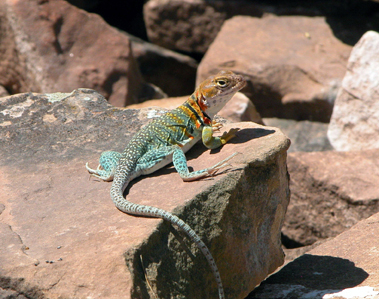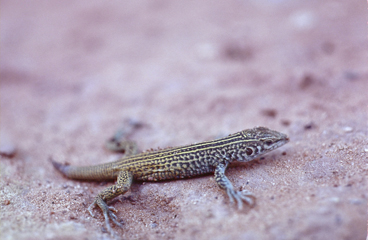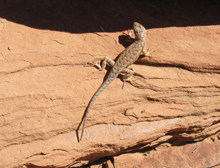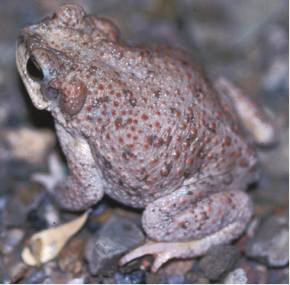Reptiles & Amphibians
Canyon Country Nature GuideReptiles
The only reptiles found in canyon country are snakes and lizards. If you are out exploring during the summer, you are sure to see lots of lizards. They are usually visible sunbathing on rocks or chasing insects with their lightning-quick reflexes.
Most snakes found here are harmless and nocturnal. All will escape from human confrontations given the opportunity. These underappreciated, sometimes feared, animals play an important role in the high desert ecosystem. Lizards and snakes help control insect and rodent populations. In turn, both are potential meals for birds and mammals.

Collared Lizard
(crotaphytus collaris)
Colorful collard lizards are easy to spot as they bask in the sun on the red rocks. This large lizard is 8″ to 15″ (20 to 38 cm) in length (including the tail). They eat mostly insects but will also eat small lizards. Collared lizards are known for their ability to run on their hind legs. They can and will deliver a painful bite if you get too close. Please view all wildlife from a distance.

Plateau Striped Whiptail Lizard
(Cnemidophorus velox)
Six to seven stripes run from head to light blue tail on this 8″ to 12″ (8 to 30 cm) lizard. No males occur in this species. Females produce unfertilized, but viable, eggs. Because the species is all female they can reproduce at a much faster rate.

Plateau Spotted Whiptail Lizard
(Cnemidophorus septemvittatus)
Six to seven black and tan spotted stripes running from head to tail over a blue green body, head, and tail. Females will often have an orange throat. They are about 12″ (30 cm) in length and their tail is usually three times their body length. These lizards are very active and can be seen dashing around the park whipping their tails from side to side.

Sagebrush Lizard
(Sceloporus graciosus)
Small scales, white on the back of the legs, and a powdered blue throat define this lizard. The sagebrush lizard is about 4″ to 5″ (10 to 12 cm) in length including the tail. Usually they are seen in areas with scattered scrubs and open ground, but they can easily climb boulders.

Gopher Snake
(Pituophis catenifer deserticola)
Gopher snakes are active active in the daytime if temperatures are cooler and at night during hot weather. They are good climbers and burrowers. This non-venomous snake is often mistaken for a rattlesnake because when alarmed, it vibrates its tail, makes a loud hissing sound and may strike vigorously. Gopher snakes eat rodents in large numbers. They are 40 to 100 inches (101 to 254 cm) in length and are golden yellow in color with dark patches of brown.

Midget Faded Rattelsnake
(Crotalus viridis concolor)
This snake looks ” faded” with its pale-cream body color with slightly darker oval splotches down the middle of its back. This is a small snake at 24 to 26 inches (61 to 66 cm) in length. It has very toxic venom, but is usually non-aggressive unless feeliing threatened, and will warn that you are too close with its distinct rattle. They lives in burrows and rock crevices and is mostly active at night.
Amphibians
A variety of frogs and toads, as well as one species of salamander, call canyon country home. Adult amphibians may wander away from water, but usually remain nearby and wait out dry periods in burrows. Amphibians lay their eggs in the potholes in the rock, springs and intermittent streams like Courthouse Wash.

Red-spotted Toad
(Bufo punctatus)
This small toad grows up to 3 inches (7.6 cm) long. It is easily identified by its large parotoid glands (directly behind the eye) and small red dots that cover their tan or grey bodies. Red-spotted toads have pale undersides.. The male’s call is a high pitched trill, something like that of a cricket, and can be heard during rainy summer nights.

Woodhouse's Toad
(Bufo woodhousii)
This toad can grow up to 5 inches (12 cm) long, and the female is larger than the male. Their body is greenish gray to yellowish brown with a white stripe running down their back that makes them easy to identify. They have dark spots and warty skin and a prominent crest behind their eyes. Woodhouse’s toads can often be seen at night, where there is light, catching bugs. During the day they may burrow in the soil.
